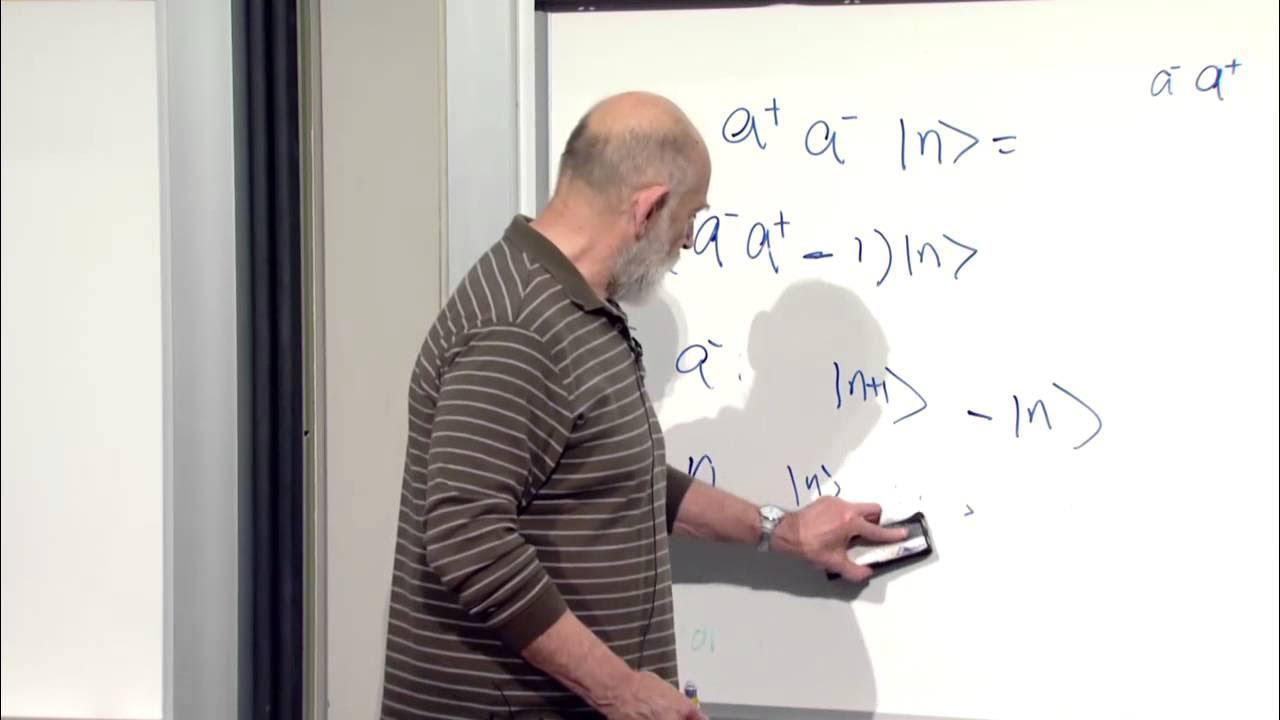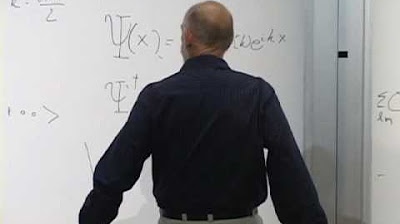Spinors for Beginners 1: Introduction (Overview +Table of Contents for video series)
TLDRThe video script discusses the concept of spinors, complex mathematical objects used in quantum physics to describe fundamental particles. It explains that while spinors are challenging to understand, they can be represented in various ways, such as the 'square roots' of vectors or members of Clifford algebras. The script outlines a five-step approach to learning spinors, starting from basic physics examples and progressing to advanced mathematical concepts, including their role in particle physics and quantum field theory. The goal is to provide a clear roadmap for understanding spinors, demystifying a topic often considered confusing.
Takeaways
- 🧠 Spinors are complex mathematical objects used in advanced quantum physics, particularly for describing fundamental fermions with spin-1/2.
- 🔄 Spinors have a unique property of transforming differently from vectors; after a 360-degree turn, they return to their negative, requiring a 720-degree turn to return to their original state.
- 📚 The speaker aims to create a video series to simplify the understanding of spinors for undergraduate and early graduate students, avoiding the frustration of complex textbooks.
- 🌟 The staircase approach to learning spinors involves starting with basic examples from physics and gradually moving to more abstract concepts.
- 🎯 Physical examples of spinors include quantum spin states and the polarization of light waves, demonstrating the angle-doubling relationship between physical and state spaces.
- 🤔 Spinors can be viewed as the 'square roots' of vectors, allowing for the factorization of a 3D vector into a column spinor and a row spinor using Pauli matrices.
- 📐 Clifford algebras provide a framework for defining spinors in any dimension, beyond just 3 or 4, and introduce higher-dimensional analogues of vectors like bivectors and trivectors.
- 🔧 Lie groups and Lie algebras are essential for understanding how different particle types transform under changes of reference frame, which is crucial for quantum mechanics incorporating relativity.
- 👤 In particle physics, particles are treated as excitations in various fields, with different spins corresponding to different types of fields and transformations.
- 🌌 The Standard Model Lagrangian, a key component of quantum field theory, models interactions between various fields, including those involving spinors.
- 🔄 The weak nuclear force's interaction with left-handed particles exclusively demonstrates the importance of chirality in quantum field theory and particle interactions.
Q & A
What is the common phrase used online to request a simple explanation?
-The phrase commonly used is 'explain like I’m 5', which asks for an explanation simple enough for a 5-year-old to understand.
What are spinors in the context of quantum physics?
-Spinors are mathematical objects that feature in advanced quantum physics, used to describe fundamental fermions with spin-1/2, which are matter-type particles constituting atoms.
How do spinors differ from vectors in terms of transformation?
-While vectors return to their original state after a 360-degree turn, spinors require two full turns, or 720-degrees, to return to their starting position.
What is Dirac's belt trick used to demonstrate?
-Dirac's belt trick is used to demonstrate the property of spinors that after one turn, they acquire a twist that cannot be removed by simply translating the free end, but after a second turn, the twist can be removed, illustrating the two-full-turns requirement to return to the original state.
How do quantum spin states relate to the concept of spinors?
-Quantum spin states, such as spin-up and spin-down, live in an abstract state space and are orthogonal to each other, with a 90-degree separation. This angle-doubling relationship between physical and state space aligns with the properties of spinors, making them suitable for describing matter particles.
What is the significance of the polarization of light in relation to spinors?
-The polarization of light, which includes states like vertical and horizontal polarization, demonstrates an angle-doubling relationship between physical space and polarization state space, similar to quantum spin states, and can thus be described using spinors.
How do spinors relate to tensors and their ranks?
-Spinors can be considered as a tensor of rank 'one half' because they can combine to form a rank-1 tensor, and they transform half as much as vectors do.
What is the role of Clifford algebras in defining spinors?
-Clifford algebras allow for the definition of spinors in any dimension, providing a framework for understanding spinors alongside other multi-vectors like bivectors and trivectors, which are useful in representing geometric ideas in physics.
How are Lie groups and Lie algebras used in the study of particle physics?
-Lie groups and Lie algebras are used to understand how different particle types transform under changes of reference frame, which is crucial for incorporating relativity into quantum mechanics and understanding interactions between various fields in particle physics.
What are Dirac spinors in quantum field theory?
-Dirac spinors are 4-component columns used in quantum field theory to represent particles with spin-1/2. They consist of a pair of 2-component Weyl spinors, one for left-handed chirality and one for right-handed chirality.
How does the weak nuclear force interact with particles in terms of their chirality?
-The weak nuclear force is known to interact only with left-handed particles, meaning that reflecting the universe in a mirror or swapping left and right-handed particles would not result in the same physics.
Outlines
🌟 Introduction to Spinors
The video script begins with a discussion on the concept of explaining complex topics in a simple manner, akin to how a 5-year-old would understand. It introduces the topic of 'spinors', which are mathematical objects used in advanced quantum physics and are known for their complexity. The script explains the fundamental categorization of particles into bosons and fermions, with spinors being used to describe fermions, which are matter-type particles. It also introduces the unique property of spinors, which involves a 720-degree rotation to return to their original state, and mentions the intention to create a video series to demystify spinors for students.
📐 Quantum Mechanics and Classical Physics
This paragraph delves into the application of spinors in quantum mechanics and classical physics. It explains how electrically neutral silver atoms behave in a magnetic field, relating to the quantum spin states of particles. The script also discusses the concept of polarization in light waves and how this can be described using spinors. The paragraph highlights the angle-doubling relationship between physical space and state space, and how this relates to the properties of spinors. It also touches on the idea of spinors as the 'square roots' of vectors, providing a mathematical perspective on their role in physics.
🧬 Clifford Algebras and Spinors
The third paragraph introduces Clifford Algebras, which are used to define spinors in any dimension. It explains the concept of higher-dimensional analogues of vectors, such as bivectors and trivectors, and how these are constructed using the 'wedge product'. The paragraph also discusses the role of spinors in Clifford algebras and how they can be defined as members of minimal left ideals. The script sets the stage for understanding the mathematical framework that underpins the use of spinors in physics.
🌌 Particle Physics and Quantum Field Theory
The final paragraph discusses the application of spinors in particle physics and quantum field theory. It explains how particles are treated as excitations in various fields and how these fields interact, as modeled by the Standard Model Lagrangian. The script introduces the concept of Dirac Spinors, which are used to describe fermions in quantum field theory, and touches on the unique interaction of the weak nuclear force with left-handed particles. The paragraph concludes by emphasizing the complexity of the topic and the intention of the video series to help viewers understand the role of spinors in physics.
Mindmap
Keywords
💡Spinors
💡Fermions
💡Quantum Mechanics
💡Euclidean Vectors
💡Clifford Algebras
💡Lie Groups and Lie Algebras
💡Particle Physics
💡Quantum Field Theory (QFT)
💡Dirac Spinors
💡Weak Nuclear Force
Highlights
People often request simple explanations for complex topics using the phrase 'explain like I’m 5'.
Spinors are mathematical objects used in advanced quantum physics and are known for their complexity.
Fundamental particles are categorized into bosons, which carry forces, and fermions, which make up atoms.
Fermions, which all known fundamental particles are, have a spin-1/2 and are represented by spinors.
Spinors have a unique property where they return to their negative after a 360-degree turn and require a 720-degree turn to return to their original state.
The concept of spinors can be introduced through the Dirac’s belt trick, demonstrating their unique transformation properties.
The speaker aims to create a video series to explain the basics of spinors for undergraduate or early graduate students.
The learning process for spinors is likened to climbing a staircase, starting with basic explanations and gradually increasing in complexity.
Physics examples of spinors include quantum spin states and the polarization of light waves.
In quantum mechanics, spin-up and spin-down states live in an abstract state space, not physical space.
Spinors can be viewed as the 'square roots' of vectors, allowing for the factoring of a 3D vector into a column spinor and a row spinor.
Clifford algebras provide a way to define spinors in any dimension, not just 3 or 4, and are useful for representing geometric ideas in physics.
Lie groups and Lie algebras are essential for understanding how different particle types transform under changes of reference frame.
In particle physics, particles are treated as excitations in various fields, and their interactions are modeled by the Standard Model Lagrangian.
Dirac Spinors, used in quantum field theory, are 4-component columns representing a pair of 2-component Weyl spinors with different chiralities.
The weak nuclear force only interacts with left-handed particles, making the study of spinors crucial for understanding particle interactions.
The video series aims to help viewers understand spinors at different levels of detail and demystify this complex topic in physics.
Transcripts
5.0 / 5 (0 votes)
Thanks for rating:





